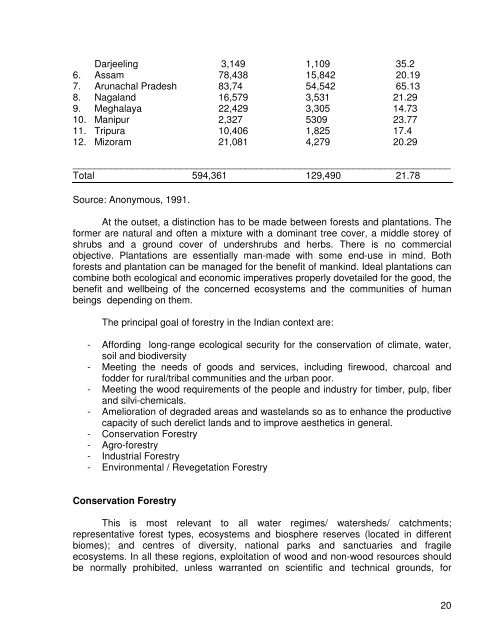Pandit Govind Ballabh Pant Memorial Lecture: II
Pandit Govind Ballabh Pant Memorial Lecture: II
Pandit Govind Ballabh Pant Memorial Lecture: II
Create successful ePaper yourself
Turn your PDF publications into a flip-book with our unique Google optimized e-Paper software.
Darjeeling 3,149 1,109 35.2<br />
6. Assam 78,438 15,842 20.19<br />
7. Arunachal Pradesh 83,74 54,542 65.13<br />
8. Nagaland 16,579 3,531 21.29<br />
9. Meghalaya 22,429 3,305 14.73<br />
10. Manipur 2,327 5309 23.77<br />
11. Tripura 10,406 1,825 17.4<br />
12. Mizoram 21,081 4,279 20.29<br />
______________________________________________________________________<br />
Total 594,361 129,490 21.78<br />
Source: Anonymous, 1991.<br />
At the outset, a distinction has to be made between forests and plantations. The<br />
former are natural and often a mixture with a dominant tree cover, a middle storey of<br />
shrubs and a ground cover of undershrubs and herbs. There is no commercial<br />
objective. Plantations are essentially man-made with some end-use in mind. Both<br />
forests and plantation can be managed for the benefit of mankind. Ideal plantations can<br />
combine both ecological and economic imperatives properly dovetailed for the good, the<br />
benefit and wellbeing of the concerned ecosystems and the communities of human<br />
beings depending on them.<br />
The principal goal of forestry in the Indian context are:<br />
- Affording long-range ecological security for the conservation of climate, water,<br />
soil and biodiversity<br />
- Meeting the needs of goods and services, including firewood, charcoal and<br />
fodder for rural/tribal communities and the urban poor.<br />
- Meeting the wood requirements of the people and industry for timber, pulp, fiber<br />
and silvi-chemicals.<br />
- Amelioration of degraded areas and wastelands so as to enhance the productive<br />
capacity of such derelict lands and to improve aesthetics in general.<br />
- Conservation Forestry<br />
- Agro-forestry<br />
- Industrial Forestry<br />
- Environmental / Revegetation Forestry<br />
Conservation Forestry<br />
This is most relevant to all water regimes/ watersheds/ catchments;<br />
representative forest types, ecosystems and biosphere reserves (located in different<br />
biomes); and centres of diversity, national parks and sanctuaries and fragile<br />
ecosystems. In all these regions, exploitation of wood and non-wood resources should<br />
be normally prohibited, unless warranted on scientific and technical grounds, for<br />
20











